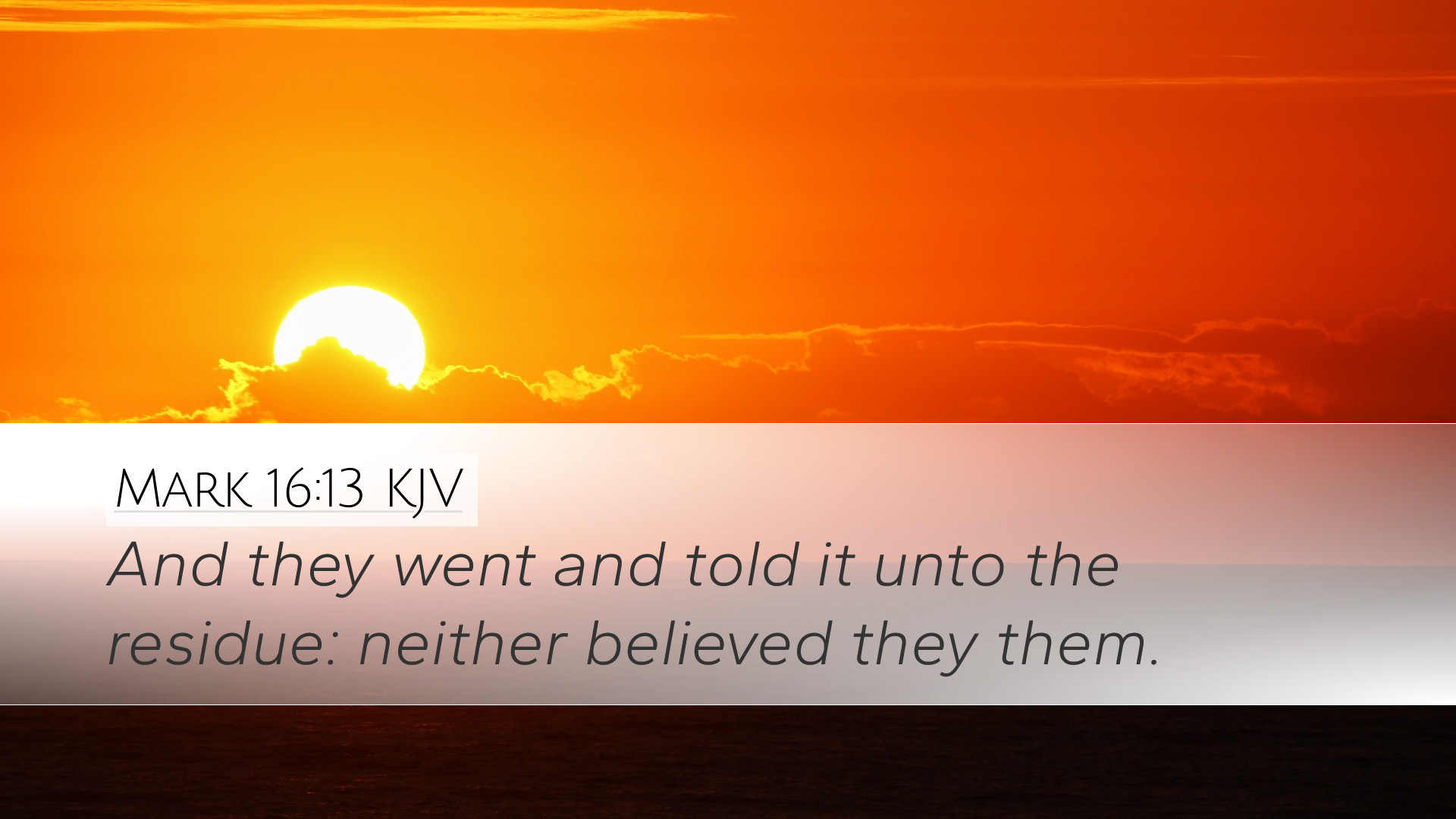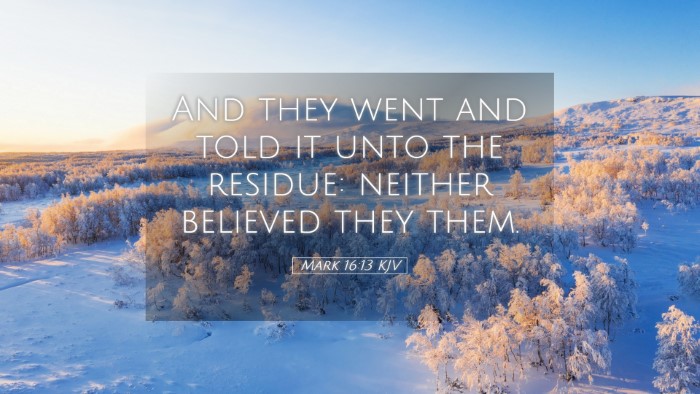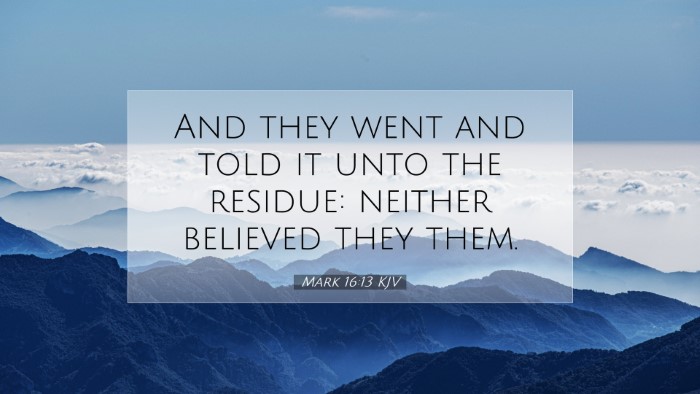Old Testament
Genesis Exodus Leviticus Numbers Deuteronomy Joshua Judges Ruth 1 Samuel 2 Samuel 1 Kings 2 Kings 1 Chronicles 2 Chronicles Ezra Nehemiah Esther Job Psalms Proverbs Ecclesiastes Song of Solomon Isaiah Jeremiah Lamentations Ezekiel Daniel Hosea Joel Amos Obadiah Jonah Micah Nahum Habakkuk Zephaniah Haggai Zechariah MalachiMark 16:13
Mark 16:13 KJV
And they went and told it unto the residue: neither believed they them.
Mark 16:13 Bible Commentary
Commentary on Mark 16:13
Verse Text: "And they went and told it unto the residue: neither believed they them."
Overview
The concluding chapter of Mark’s Gospel presents a unique insight into the post-resurrection appearances of Jesus. Mark 16:13 falls within the context of the resurrected Christ's encounters with his disciples, who have grappled with disbelief and confusion. The implications of this verse reach deeply into themes of faith, testimony, and the human experience of doubt.
Exegesis
This verse addresses the response of the disciples after witnessing the risen Christ, as detailed by public domain commentaries by notable theologians:
Matthew Henry’s Commentary
Henry emphasizes the persistent doubt among the disciples despite encountering witnesses of great significance. He notes that the report of the two disciples who had walked with Jesus and the report of Mary Magdalene were met with skepticism. This skepticism highlights a profound human condition—often, even the most credible testimonies are dismissed.
Albert Barnes’ Notes
Barnes offers a perspective on the implications of disbelief among the witnesses of the resurrection. He points out that the refusal to accept the testimonies reveals not only a lack of faith but also the deeply ingrained doubt that can reside in human hearts. This verse serves as an illustration of the psychological struggles within the early Christian community, which are relatable to contemporary believers who wrestle with faith in the face of doubt.
Adam Clarke’s Commentary
Clarke expands on the nature of the witnesses—two individuals who encountered Christ and were commanded to share the good news. He provides an analysis of the cultural and emotional barriers that obstructed belief, emphasizing that the reluctance to believe highlights significant challenges faced both in the early church and today, when urging faith in troubling times.
Thematic Insights
- The Challenge of Disbelief: This verse reflects that even with evidence of the resurrection, belief can be difficult. It resonates with the Christian experience where the unseen can often feel more tangible than the seen.
- The Role of Testimony: The reactions of the disciples underline the crucial role of testimony in faith. The act of sharing experiences serves to strengthen community belief.
- Human Frailty: This passage resonates with the theme of human weakness. The disciples' skepticism invites reflection on our own struggles with faith and trust.
Theological Reflections
The theological implications of Mark 16:13 are profound, underscoring the journey from skepticism to faith as a central element in the narrative of salvation. The reluctance of the disciples to accept the resurrection supports the concept of faith as a dynamic growth process:
- Faith Development: The experiences of the disciples mirror the spiritual journey where faith is often achieved through struggle and questioning.
- Grace Extended to Doubters: This narrative reassures believers that doubts do not disqualify them from God's grace. Jesus’ approach to disbelief offers hope for all who wrestle with their faith.
- Testimony as a Means of Grace: The reliance on personal testimony in faith formation is a crucial element of Christian practice, as seen in the distribution of the resurrection news.
Practical Applications
For pastors, students, and theologians, Mark 16:13 challenges the ways in which the Church engages with testimonies of faith. The following applications can be drawn:
- Encouragement for Doubters: Pastors should create spaces for doubts within faith communities, offering pastoral care to those struggling to believe.
- Emphasis on Testimony: Sharing personal faith journeys can be a powerful tool for building a supportive faith community, mirroring the experiences conveyed in the passage.
- Education on the Nature of Faith: The Church should teach about the nature of belief and doubt, helping congregants understand that skepticism does not exclude one from faith.
Conclusion
Mark 16:13 calls the reader to consider the multi-faceted nature of faith in the Christian experience. It serves as a reminder that disbelief can coexist with the journey toward belief. The exchange between the early disciples and the witnesses of the resurrection encourages us to embrace our doubts while being open to divine truths. In doing so, we contribute to a rich theological dialogue that honors the complexity of faith, testimony, and the work of grace in our lives.


